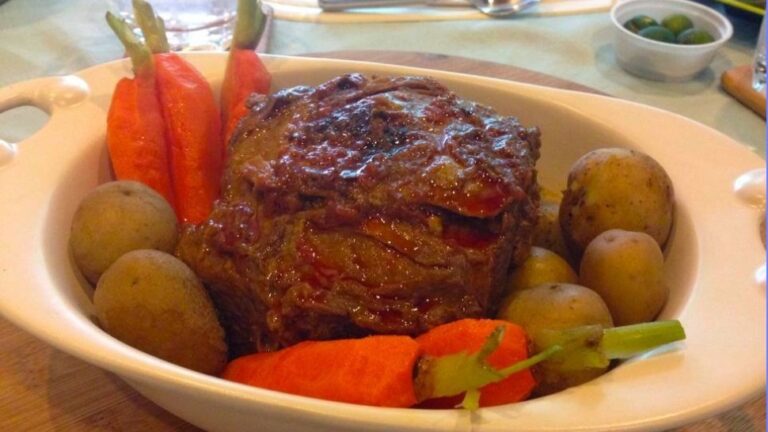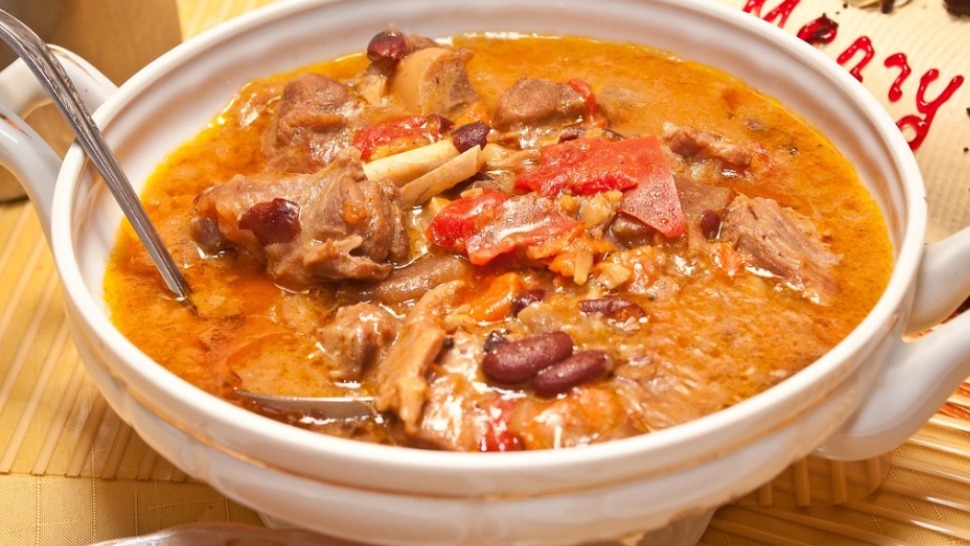
By Roberto Villar | Reprinted from Dec 30, 2019 esquiremag.ph
As 2019 is about to draw to a close, we reflect on the many highlights that have transpired this year. Some of these highlights could be found in local social media. One that particularly took netizens by storm was a debate about the differences among mechado, afritada, kaldereta, and menudo.
It all began with a series of memes, all humorous and all of good nature. However, it made a great many Filipinos reassess the categorization of their own cuisine, questioning how well they know some of the favorite country’s fare. It turns out that many have a difficult time figuring out what sets each apart. Up to now, even as the “memetic wave” has ebbed, there are still discussions occurring in quiet corners online.
If you’re still wondering, yes, they all have red sauce, but how could they be any more different?
So, for those out there who are still left in the dark, here are not only the differences between mechado, afritada, kaldereta, and menudo but also the fascinating roots of each dish.
The Roots of Mechado
Mechado is traditionally the oyster blade cut of the beef that has been larded with pork fat and braised in broth flavored with onions. It was derived from the Spanish term for wick or mecha augmented by the suffix ado which in English is the equivalent of the suffix ful. The pork fat being larded in the beef resembles the wick of a candle and a literal English translation of mechado is “wickful” or “full of ‘wick'” – which it is. Contrary to popular belief, mechado did not originally have tomatoes as that was a later addition. In fact, they were only an option and not at all necessary, but salt (or soy sauce) and vinegar are essential seasonings.
A vintage recipe of note simply calls for half a pound of meat, a piece of fat two inches thick, a chicken egg, two teaspoons of vinegar, and three teaspoons of oil; to which the instructions state:
“The eggs should first be boiled very well, peeled and chopped. Stuff the fat and the eggs into the meat. Soak in vinegar, add some pepper and season with salt. After ten minutes, sautee [sic] in oil and once brown, add a glass and a half of water and slowly simmer until the sauce thickens.”
The roulade was usually served sliced and cascading above the vinegar reduction.
Initially, the dish was a way for cash-strapped locals to salvage the inexpensive yet tough cuts of meat. The practice of larding was something they learned from their colonizers. Larding was a European culinary method and has been utilized by the likes of the French and the Spanish. An al-Andalus recipe dating back from the 13th century for mechada describes larding meat along with scallions and frying slices of the larded meat in olive oil, pouring broth afterwards and then breaking a few eggs over the half-cooked stew; adding vinegar and the Arabic condiment known as murri.
Carne mechada, a delicacy enjoyed in Western Andalusia, does away with the larding and has a pork loin simmered in a wine-flavored broth. What is interesting is that in both Puerto Rico and the Dominican Republic, both former colonies of Spain, their carne mechada—slices of meat that were stuffed with a fat-based filling—ham for the former, longaniza (raw pork sausage with fat) for the latter—and served with a tomato-based sauce, is much more analogous to our own version.
A modern if bastardized version of mechado involves cubed pieces of beef simmered in tomato sauce, with potatoes and carrots as filler ingredients, as a much more economical approach. Unfortunately, this incarnation akin to beef stew—because it is easier to prepare—has gradually outclassed the original, leaving the mecha angle irrelevant and adding to the brewing confusion.
The Roots of Afritada
Afritada comes from the Spanish phrase a fritada, which means to fry. It is chicken or pork that is lightly-browned and then braised in broth flavored with garlic, tomatoes, and bell peppers, and then seasoned with fish sauce and vinegar (or sour citrus, calamansi being the most common).
A distant relative from Spain is chilidrón, a preparation from the Ribera Navarra region which has either lamb or chicken fried on a shallow amount of olive oil and then simmered in a blend of wine, garlic, onions, tomatoes, and the key ingredient, bell peppers. Celebrated American writer Ernest Hemingway cited the original lamb variant, cordero al chilidrón, among his favorite Spanish foods. The procedure is not unlike our afritada, while the chicken variant, pollo al chilidrón, looks similar to afritadang manok and may in fact have been our adaptation of that.
The Roots of Kaldereta

Kaldereta is a piquant goat stew wherein its defining characteristic is that it is thickened with a liver mash. Traditionally, the liver was from the goat, but due to its strong and gamey flavor, cooks opt for the much milder chicken liver. A popular alternative born out of convenience is to apply canned liver spread, with Reno as the go-to brand for preparing kaldereta. Bay leaves and chili peppers are often added for spice and spiciness, respectively. As with mechado, tomatoes may be added but they are not meant to be the primary ingredient; the taste and flavor profile should be more prominent on the liver, bay leaves, and chili peppers.
It is a localization of caldereta, which originated in the Castile and León region of Spain. Over there, lamb is the main viand in Castilian caldereta as they flock in abundance and are in fact the main product of the region. As for the entomology, caldereta is named for the stock pot it is cooked in, known as a caldero, which in turn stemmed from the term cálido. As Spanish food scientist Borja Sánchez puts it:
“Cálido means warm. Caldero is the warm place where you cook. Caldereta is a warm dish cooked in a caldero.”
Hence, recipes would have the lamb placed inside a caldero and stewed in an aromatic broth along with its own liver. You may ponder that, since lamb was not readily available in the Philippine islands at that time, goat would have been the next best thing.
Nowadays a popular variation features beef instead of goat, as the discriminating in palate are not so fond of the latter. This, again, adds more confusion to the problem.
The Roots of Menudo
Menudo is pork liver sliced into smaller pieces: menudo is Spanish for tiny. After dicing, the meat is stir-fried, and then simmered in a thick sauce flavored with tomatoes. Potatoes, carrots, and peas are optional. Extra cuts of pork meat are also added to extend the yield. It is known in the Visayas as ginamay, while an Ilokano variant exists and is known as higado, which means liver in Spanish. Due to the prominence of pork liver and rather compact appearance, this is by far the easiest to pinpoint out of the four.
While we have no exact documents on how menudo came about; there is also a similar dish named menudo found in Mexico, another former colony of Spain. The Mexican counterpart is a soup made with beef tripe that had been cut into smaller pieces, as well, and boiled for several hours until nice and tender. Hominy (pozole) or corn kernels that have been soaked in an alkaline solution, are also incorporated into the soup. There are two varieties: menudo rojo with red chili peppers, and menudo blanco without. They are a popular item in fondas, family-run hole-in-the-wall restaurants, and because of its time-consuming process, are beloved fare in both Sunday lunches and special occasions.
Analogous to Mexican menudo is callos de Cadiz, another town in Spain’s Andalusian region, which is also referred to as menudo. Similar is the slow cooking of tripe and the addition of starchy kernels, this time being chick peas or garbanzos. The Mexican culinary community, Larousse Cocina, acknowledges this:
“There is a dish in Spain very similar to our often, the famous Callos, which surely was the origin of the stew we know. Though in Mexican territory, as expected, Chile was immediately added.”
In the 1844 Mexican cookbook La cocinera de todo el mundo, o la cocina sin cocinera: coleccion de las mejores y mas escelentes recetas, a recipe can be found for menudo à la española. Chopped meat is sautéed with onions, garlic, parsley, hierbabuena (an herb from the mint family), and tomatoes; thickened with bread crumbs and simmered in water seasoned with salt and vinegar. Somehow this seems more similar with ours, as the addition of bread crumbs thickens the braising liquid; sharing almost the same viscosity as Philippine menudo. The sautéing of the aromatics, an application of acid (vinegar for them, calamansi for us) and a subsequent immersion are also shared between the two cooking styles, rather than a direct boil.
There are also recipes from Spain like the one found in La cocinera that use goat (menudo de chivo); and in the case of menudo sevillano, veal and chorizo. In Gene Gonzalez’s Cocina Sulipeña: Culinary Gems from Old Pampanga, a book which documents food traditions from his hometown of Sulipan, he curated of a heirloom recipe for menudo sulipeña, a menudo that is more in touch with the Spanish version; complete with chick peas, chorizo, and a splash of brandy. The presence of oxtail rather than tripe could classify this as a hybrid with rabo de toro. What they all have in common, together with the mainstream Mexican and Philippine interpretations, is that they require meat that have been fabricated into smaller bite-sized pieces and cooked compactly in a savory tomato base, mainly featuring a sort of starch.
From these findings; we can honestly say that these Philippine dishes can really be traced back to Spain, rather than vaguely attributed to the latter without prior evidence. Felice Sta. Maria wrote in her book, The Governor-general’s Kitchen: Philippine Culinary Vignettes and Period Recipes 1521-1935, that the arrival of the Spanish affected the way we prepared and ate meals. Not surprising, we have adopted some of their fare as our own. All of them, except for caldereta, originated from the Andalusian region, a region with an Arabic past. So much that probably those who introduced the techniques we apply in our adaptations were from Andalusia, and in a sense, Filipino cuisine also has indirect Arabic influences through the osmosis of European settlement.
In learning more about our cuisine, we learn more about ourselves as a nation. While the memes were amusing on the surface, it is a sad reflection of national concern. The uncertainty of which food is which can be faulted at the lack of passing down crucial history to the next generation, whether it is taught at school or at home. And thus; mechado, afritada, kaldereta, and menudo can continue becoming as homogenized as the ready-made tomato sauce mixes that hold their namesakes, unless there is awareness. It is not too late, after all, to bring these traditions back while we still have texts and testimonies on how to prepare them.
Sources:
Anonymous. (1844). La cocinera de todo el mundo, o la cocina sin cocinera: coleccion de las mejores y mas escelentes recetas. Mexico: Juan Nepomuceno del Valle.
Huici, A.M. (1966). Traduccion espanola de un manuscrito anonimo del siglo 13 sobre la cocina hispanomagribi. Madrid: Maestre.
Iribarren, J.M. (1984). Hemingway and the Sanfermines. Pamplona: Editorial Gómez.
Gonzalez, G.R. (1993). Cocina Sulipeña: Culinary Gems from Old Pampanga. Manila: Bookmark.
Sta. Maria, F.P. (2006). The Governor-general’s Kitchen: Philippine Culinary Vignettes and Period Recipes 1521-1935. Manila: Anvil.
Sanchez, B. (2019, May). Personal Interview.
Diccionario gastronómico (n.d.). Retrieved from https://laroussecocina.mx
Mechado. (n.d.). Retrieved from www.tagaloglang.com
Pollo al chilindron (n.d.). Retrieved from www.spain-recipes.com